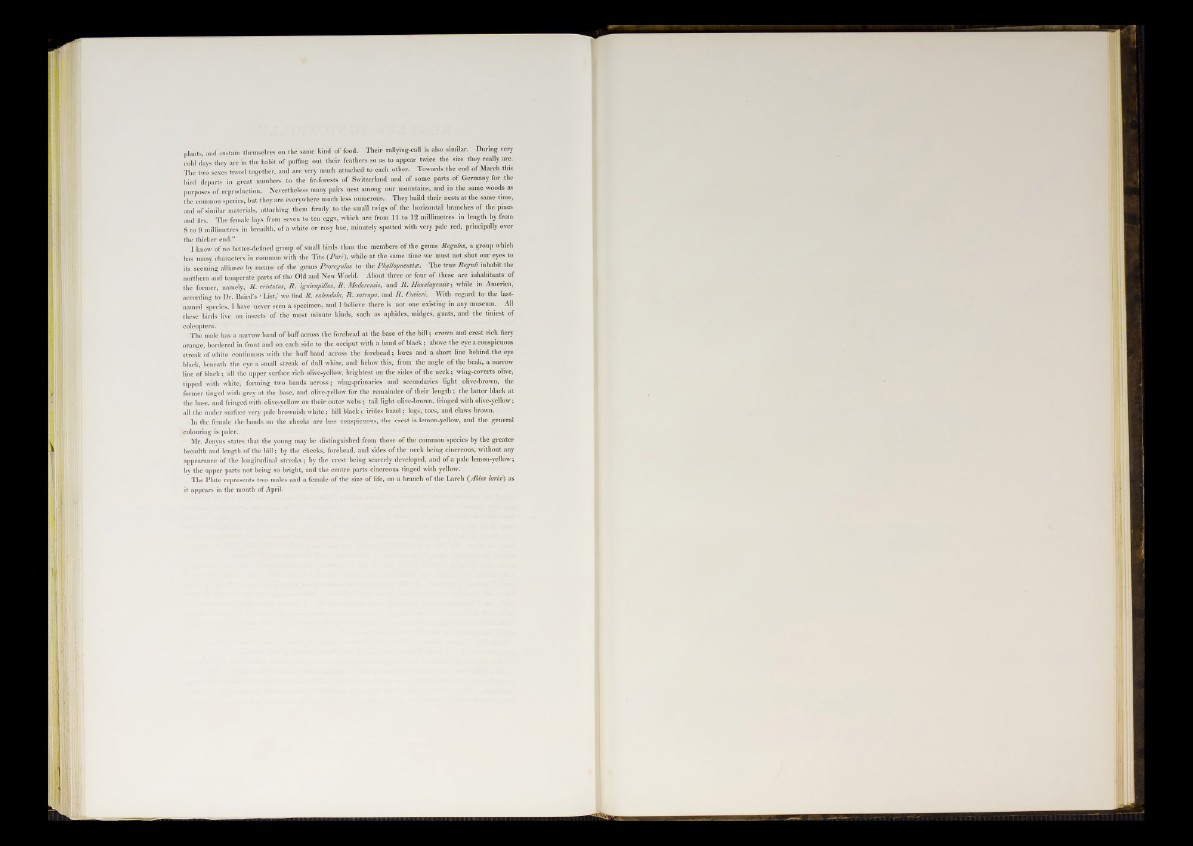
plants, and sustain themselves on the same kind of food. Their rallying-call is also similar. During very
cold days they are in the habit of puffing out their feathers so as to appear twice the size they really are.
The two sexes travel together, and are very much attached to each other. Towards the end of March this
bird departs in great numbers to the fir-forests of Switzerland and of some parts of Germany for the
purposes of reproduction. Nevertheless many pairs nest among our mountains, and in the same woods as
the common species, but they are everywhere much less numerous. They huild their nests at the same time,
and of similar materials, attaching them irmly to the small twigs of the horizontal branches of the pines
and firs. The female lays from seveu to ten eggs, which are from 11 to 12 millimetres in length by from
8 to 9 millimetres in breadth, of a white or rosy hue, minutely spotted with very pale red, principally over
the thicker end.”
I know of no better-defined group of small birds than the members of the genus Regulas, a group which
has many characters in common with the Tits (Parr), while at the same time we must not shut our eyes to
its seeming alliance bv means of the genus Praregalas to the PhyUnpneiistx. The true Reguli inhabit the
northern and temperate parts of the Old and New World. About three or four of these are inhabitants of
the former, namely, R . crista!us, R . igmcapillus, R . Maderensis, and R . Himalayensis; while in America,
according to Dr. Baird's ‘List,' we find It- calendula, R . satrapa, and R. Cameri. With regard to the last-
named species, I have never seen a specimen, and I believe there is not one existing in any mnseum. All
these birds live on insects of the most minute kinds, such as aphides, midges, gnats, and the tiniest of
coleóptera.
The male has a narrow band of buff across the forehead at the base of the b ill; crown and crest rich fiery
orange, bordered in front and on each side to the occiput with a band of black; above the eye a conspicuous
streak of white continuous with the buff band across the forehead ; lores and a short line behind the eye
black, beneath the eye a small streak of dull white, and below this, from the angle of the beak, a narrow
line of black; all the upper surface rich olive-yellow, brightest on the sides of the neck; wing-coverts olive,
tipped with white, forming two bands across; wing-primaries and secondaries light olive-brown, the
former tinged with grey at the base, and olive-yellow for the remainder of their length;' the latter black at
the base, and fringed with olive-yellow on their outer webs; tail light olive-brown, fringed with olive-yellow;
all the under surface very pale brownish white; bill black; irides hazel; legs, toes, and claws brown.
In the female the bands on the cheeks are less conspicuous, the crest is lemon-yellow, and the general
colouring is paler.
Mr. Jenyns states that the young may be distinguished from those of the common species by the greater
breadth and length of the bill; by the cheeks, forehead, and sides of the neck being cinereous, without any
appearance of the longitudinal streaks; by the crest being scarcely developed, and of a pale lemon-yellow;
by the upper parts not being so bright, and the centre parts cinereous tinged with yellow.
The Plate represents two males and a female of the size of life, on a branch of the Larch (Abies larix) as
it appears in the month of April.